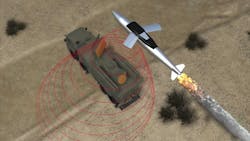Wanted: high-power RF and microwave amplifiers for electronics-killing electronic warfare (EW) systems
ARLINGTON, Va. – U.S. military researchers are asking industry to develop high-power RF and microwave amplifiers able to generate sufficient electromagnetic radiation to damage or kill enemy electronics.
Officials of the U.S. Defense Advanced Research Projects Agency (DARPA) in Arlington, Va., has issued a broad agency announcement (HR001121S0017) for the Waveform-Agile RF Directed Energy (WARDEN) project.
WARDEN seeks to develop high-power microwave amplifiers that generate enough electromagnetic radiation to disrupt, disable, or damage targeted electronic components and circuits.
The project also seeks to develop theory and computational models to describe the coupling of electromagnetic radiation into complex enclosures via unintentional paths like seams, apertures, and cable entry points, and to develop agile waveform techniques that can cause damage to enemy electronics.
Related: Air Force looking for power sources and antennas for future high-power microwave weapons
Agile waveforms refer to time-dependent signals that combine frequency, amplitude, and pulse-width modulations to make the most of coupling into a complex enclosure, and are optimized to produce disruptive effects on internal electronic components and subsystems.
The WARDEN electronic warfare (EW) program has three technical areas: high-power microwave traveling-wave amplifier; rapid assessment and numerical generation of electromagnetic response (RANGER); and agile waveform development. The high-power microwave traveling-wave amplifier and agile waveform portions are classified, and the Ranger portion is not.
High-power microwave systems are radio-frequency directed energy weapons that use electromagnetic radiation to disrupt, disable, or damage targeted electronic components and circuits.
The advantages of high-power microwave systems include non-kinetic, wide-area effects at long stand-off distances; deep magazines; operation in adverse environmental conditions; and speed-of-light engagement, DARPA researchers explain.
Related: The new era of high-power electromagnetic weapons
Electromagnetic radiation can couple into targets in band via intentional ports such as antennas. This is called a front-door electromagnetic attack. These systems also can couple into targets in band via unintentional coupling paths such as seams, apertures, and cable-entry points. This is called a back-door attack.
Today's high-power microwave systems typically use oscillators as their RF source, operate at a fixed frequency, are not easily tunable, and lack the phase coherence necessary for power combining.
Front-door systems have the longest range, but their effectiveness is limited to specific classes of targets. Back-door systems are effective against a wider variety of targets, but their range is limited by electromagnetic coupling inefficiencies due to their lack of frequency tunability.
Agile waveforms, combined with broadband high-power amplifiers, can make enemy electronics more susceptible to back-door attacks, and significantly can extend the range and effectiveness of high-power microwave weapon system.
Related: Directed-energy weapons taking big steps forward
WARDEN seeks to develop flexible technology that can be useful against a wide variety of target types by developing high-peak-power amplifiers for back-door attacks. Unlike oscillators, a broadband amplifier is agile enough to make the most of electromagnetic coupling into targeted electronics by improving coupling frequencies even with modest tuning.
Broadband amplifiers also support waveform modulations that can make enemy electronics more vulnerable to disruption by electromagnetic radiation. Combined, these effects can increase the range of back-door high-power microwave directed-energy weapons.
Yet high-power broadband amplifiers have proven extremely difficult to build because their gain and frequency capabilities are unstable and prone to oscillation. Input/output couplers and high-power vacuum windows also can be a problem.
Understanding the physics of electromagnetic wave coupling into a complex enclosure, and the interaction with internal electronics is critical to improving the effectiveness of back-door high-power microwave attacks, researchers explain.
The big challenge here is developing computationally efficient time- domain models that can simulate electromagnetic wave interaction with large structures containing features of widely varying sizes and material properties.
The main challenges for developing agile waveforms are developing physics-based computational tools to predict high-power microwave effects on electronics; creating agile waveform techniques to produce the most damaging effects on enemy electronics.
WARDEN will be a four-year, three-phase program that will develop and demonstrate the first broadband high-power microwave amplifier using high-peak and average-power handling; broadband input and output coupler design; broadband vacuum window design; and thermal management.
The project also will develop physics-based models to enable the rapid prediction of agile electromagnetic waveforms coupling into complex enclosures and the spatial distribution of the internal electric fields. It also will extend testing and modeling to broad classes of target systems to create a physics-based computational framework to predict high-power microwave effects.
Related: Lockheed Martin to develop high-power microwave weapons to destroy or disable enemy drones
DARPA researchers expect to spend about $51 million over the four-year duration of the WARDEN program, and involve several contractors.
Companies interested should submit full proposals no later than 16 April 2021 to the DARPA BAA Website at https://baa.darpa.mil. Email questions or concerns to David Abe, the WARDEN program manager, at [email protected].
More information is online at https://beta.sam.gov/opp/20104a5bdcb74ede858ea45a82345ae4/view.
About the Author
John Keller
Editor-in-Chief
John Keller is the Editor-in-Chief, Military & Aerospace Electronics Magazine--provides extensive coverage and analysis of enabling electronics and optoelectronic technologies in military, space and commercial aviation applications. John has been a member of the Military & Aerospace Electronics staff since 1989 and chief editor since 1995.
